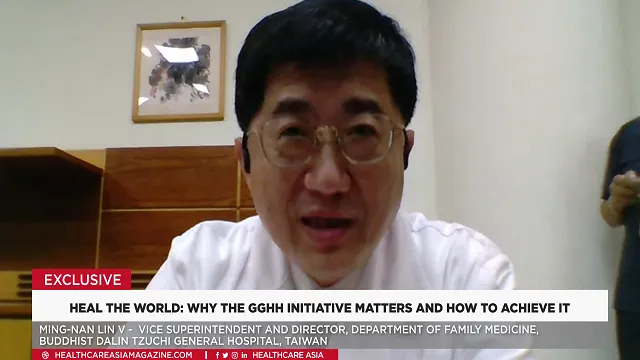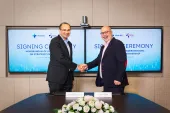
Why procurement is the biggest hurdle in green hospital goals—and how to conquer it
Procurement is amongst the 10-goal GGHH framework for hospitals to achieve net-zero by 2050.
Most hospitals spurred medical innovations on saving lives but missed an opportunity to protect the world where patients live. But not Buddhist Dalin Tzuchi General Hospital of Taiwan, which is one of the 1,500 members of the Global Green and Healthy Hospitals (GGHH) community.
Ming-nan Lin, vice superintendent and director of family medicine at Buddhist Dalin Tzuchi General Hospital of Taiwan, spoke with Healthcare Asia, to discuss how they followed the comprehensive framework under 10 GGHH goals to improve their greenhouse goal program and could lead them to achieve a net-zero goal by 2050, which seeks to limit global warming to 1.5°C by enforcing strict climate policies and innovations.
Amongst the 10 goals that they follow are leadership, chemicals, waste, energy, water, transportation, food, pharmaceuticals, buildings, and purchasing.
For Lin, he said their hospital encountered challenges in the procurement of sustainable medical equipment with the absence of a framework that would calculate the carbon footprint of such tools.
To prove his point, Lin mentioned that there is a call to replace even inhalers for asthma patients and anaesthetic gas—which contributes to global warming 10,000 more than carbon dioxide— with more eco-friendly options as both hospital care needs emit greenhouse gases that will cause global warming.
Although difficult, Lin noted that they learn from hospital practices, such as in the UK, to calculate the carbon footprint from the transportation of patients to medical devices being used for treating their patients.
What drew you to joining the GGHH network and realising its goals?
In the year 2012, when Taiwan held the Health Promoting Hospital (HPH) international conference, we had a pre-conference for green hospitals. That is the year we knew about the GGHH initiative that is from Healthcare Without Harm.
The GGHH network and Healthcare Without Harm released the GGHH 10-goal manual, in which we are agreeing that, as a hospital, we want to reduce the environmental impacts besides taking care of the patients.
We also want to work on our environmental impacts; and the GGHH 10 goals let us check up on the 10 greenhouse growth domains.
In 2012, our hospital helped our government to write the book. We call it the Taiwan Green Hospital Experience, which is called Green Hospital Green Life in Green Planet. Then, we shared our experiences.
But the GGHH 10 goal provides us a comprehensive framework that we can check on our greenhouse goal program so that we can investigate, we can audit what we have done in our hospital and also share our experience to the other hospitals.
Amongst the 10 GGHH goals, which were the easiest ones to achieve?
As for me, I think that leadership is the easiest because we got very strong support from the hospital and also from the foundation. We belong to Tzu Chi Fund Medical Foundation, and Tzu Chi Foundation is chartered and founded by our Dharma Master Cheng Yen.
From the beginning of the foundation, she told us that the mission of our foundation is not only to help people, but reducing the environmental impacts and also cherishing the environment. The various strong support from our foundation and also the hospital, which can lead us to arrange many greenhouse programs, and then also training our colleagues, and also investing in energy reducing facilities, and also the greenhouse buildings. I think that the strong support from the leadership is the way that we think we were, it is one of the easiest goals that we can achieve.
Which of these goals were quite difficult to reach?
It is the procurement. In Taiwan, we don't have quite a comprehensive system to identify the footprint of each product so we need more support or more guidelines from our government or from other non-government organisations (NGOs) to focus on calculating the carbon footprint of different medical products.
We now try our best to procure products with a less carbon footprint, but it is not easy because not all the products have this kind of information that we can buy.
How can hospitals address this procurement issue?
There are so many ways that we can do to reduce the environmental impact of hospitals. Mostly we focus on reducing the use of energy, recycling the waste, and so forth. But more than half of the carbon footprint produced in hospital services is determined by procurement. According to lifecycle analysis, the carbon footprint of the product we used is decided mostly during the manufacturing process. If we want to reduce the carbon footprint of the medical services, we need to have information about which product is more environmentally friendly. However, currently, in Taiwan and also I think in most countries, we don't have enough information about which product is better for the environment. The health care sector has to work together using the bargaining power for medical product procurement.
At the moment, what assessment can you give your institution in terms of meeting the GGHH and the global goal of net-zero emissions by 2050?
Now, we are the first one in Asia to join Race to Zero 2050. We try to study experiences from other countries such as National Health Services (NHS) from the UK because I attended a COP 26 (26th United Nations Climate Change conference) in Glasgow last year, and then they have already done this kind of assessment from there in the NHS.
So whilst we learn from them, we also try to assess, we try to audit the carbon footprint of the hospital. Thanks to Healthcare Without Harm because whenever we don't know the exact way to calculate our carbon emission, we ask them, and then they provide us some information and also ask an expert to teach us.
Now, there are still some items we still need to work on but I think that we will try our best and then it is quite okay because, with the support of our leadership and our foundation, we think that we can go on to take the challenge of Race to Zero by the year 2050.
Can you expound more on what information you learned from UK experts regarding the auditing of carbon footprint?
At the WHO conference at United Nations Framework Convention on Climate Change COP 26, the NHS of the United Kingdom shared their experiences in the race to zero by 2050. It is not easy to exactly calculate the carbon footprint in health services. Besides the energy used, and medical waste produced, we also need to calculate the carbon footprint from the transportation of the staff, patients, and their families.
There are also many greenhouse gases that will cause global warming more than 10,000 times compared with carbon dioxide, such as anaesthetic gas. The inhaler for asthma patients will also produce greenhouse gas. Some pharmaceutical companies try to replace the inhaler with other devices which are more environmentally friendly.
What advice can you give other hospitals that would also like to adopt the GGHH initiative?
I think that because most healthcare professionals and hospitals aim to improve the medical quality and also patient safety, the environment or the climate change issue are maybe not their priority.
We need to go upstream, we treat the patient and treat the diseases, but we need to keep our patient healthy so we need to improve or reduce the possible risk that is causing our fellow citizens to be sick.
A hospital is one of the buildings or one of the organisations that will produce a lot of waste and also use a lot of natural resources. I think that we need to think more because if we don't do anything about this, then there are more and more patients and more and more diseases we need to cure.
From the policy side and from practices side, we need the help of Healthcare Without Harm, or from other NGO like Global Climate and Health Alliance, these these kinds of NGOs, who can advocate for the climate change issue, and then let all the healthcare professional and all the hospital administrators, and then all the governments know the importance of climate change and health.
What projects do you have in your pipeline that revolve around this agenda?
We have a lot of the projects but I think that the Race to Zero by the year 2050 campaign, we know the scope. According to this kind of scope item, we work on each one to reduce our carbon footprint. We also joined the Rise Taiwan Alliance to help our federal hospitals, hospitals around Taiwan, and GGHH member hospitals.
Also, we work together because we, in Taiwan, share the same experience, we may face the same problems. We try to push our government to support the green hospital programs. We also joined the healthcare climate challenge. And now, Healthcare Without Harm Climate Impact Checkup is a training tool, and then they will hold this kind of training workshop, and then we will also invite our federal hospital colleagues to join this climate impact checkup tool training workshops.



















 Advertise
Advertise






